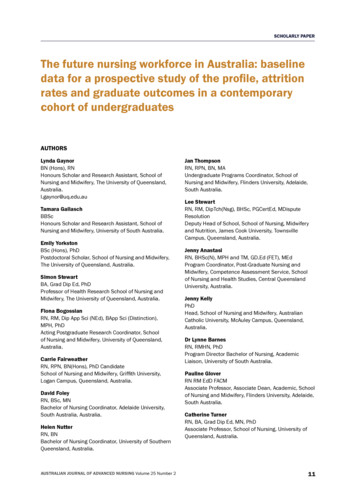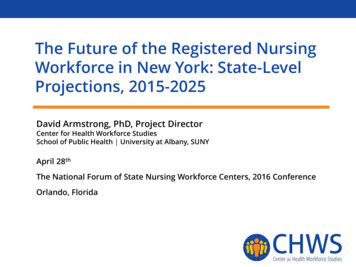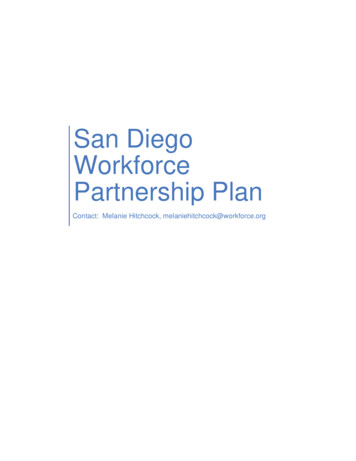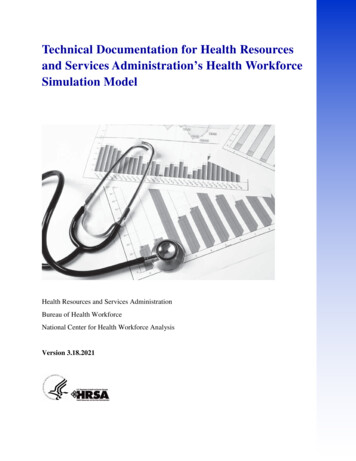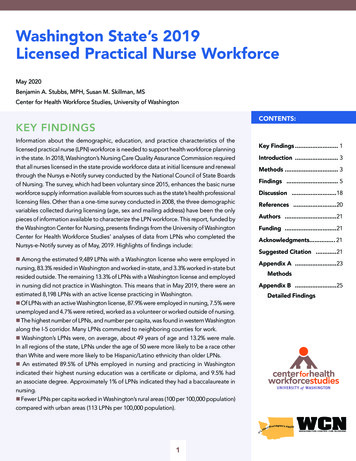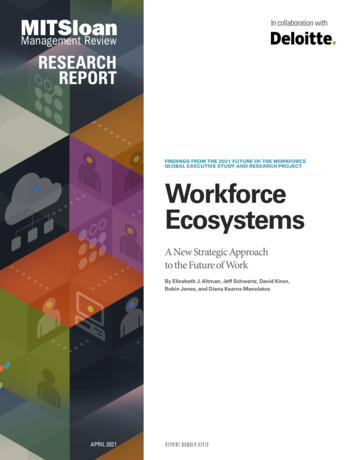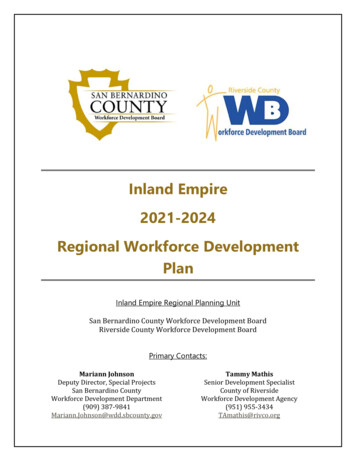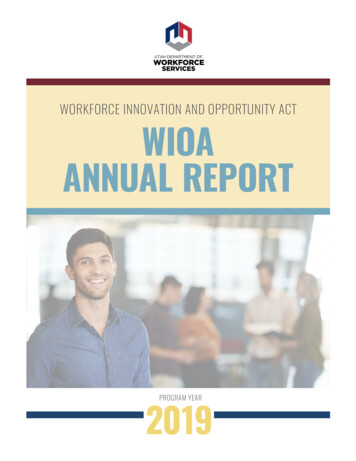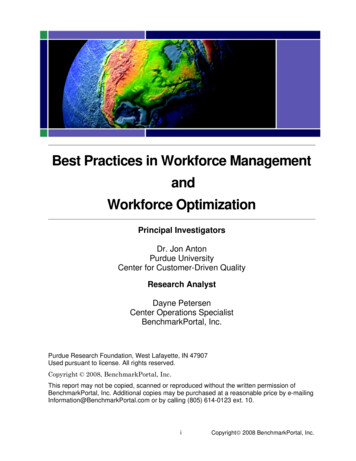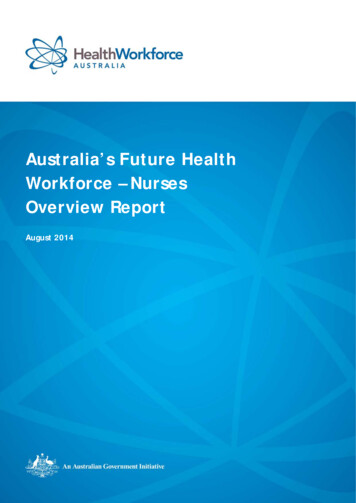
Transcription
Australia’s Future HealthWorkforce – NursesOverview ReportAugust 2014
Commonwealth of Australia 2014This work is copyright. You may download, display, print and reproduce the whole or partof this work in unaltered form for your own personal use or, if you are part of anorganisation, for internal use within your organisation, but only if you or your organisationdo not use the reproduction for any commercial purpose and retain this copyright noticeand all disclaimer notices as part of that reproduction. Apart from rights to use aspermitted by the Copyright Act 1968 or allowed by this copyright notice, all other rightsare reserved and you are not allowed to reproduce the whole or any part of this work inany way (electronic or otherwise) without first being given the specific written permissionfrom the Commonwealth to do so. Requests and inquiries concerning reproduction andrights are to be sent to the Communication Branch, Department of Health, GPO Box 9848,Canberra ACT 2601, or via e-mail to copyright@health.gov.au.The Australia’s Future Health Workforce – Nurses Overview report was developed byHealth Workforce Australia with the input of key stakeholders for the consideration ofCommonwealth, State and Territory Health Ministers.Health Workforce Australia was abolished on 8 October 2014.The Australia’s Future Health Workforce – Nurses Overview report was approved forpublication by the Commonwealth and all State and Territory Health Ministers on 10October 2014.The recommendations contained in the Australia’s Future Health Workforce – NursesOverview report will be the subject of further consideration.Enquiries concerning this report and its reproduction should be directed to:Department of HealthGPO Box 9848Canberra ACT 2601enquiries@health.gov.auSuggested citation: Health Workforce Australia 2014: Australia’s Future Health Workforce –Nurses OverviewAustralia’s Future Health Workforce – Nurses – OverviewPage i
ContentsContents . iiList of tables . iiiList of figures . ivPreface. vAcknowledgements . viExecutive summary . viiRecommendations . ixIntroduction . 1Australia’s current nursing workforce . 5Australia’s future nursing workforce. 14Conclusion . 28Glossary . 29Appendix A: Project Advisory Group members . 30Appendix B: Workforce planning data sources . 32Appendix C: Workforce planning methodology . 34Australia’s Future Health Workforce – Nurses – OverviewPage ii
List of tablesTable 1: Employed registered nurses and enrolled nurses, age profile, 2009 and 2012 . 8Table 2: Average weekly hours, employed registered nurses and enrolled nurses, 2009 and2012 . 9Table 3: Employed registered nurses by sector (public/private) 2009 and 2012. 9Table 3a: Employed enrolled nurses by sector (public/private) 2009 and 2012 . 10Table 4: Commencing enrolments, students undertaking programs of study required forinitial registration as a RN, by gender, 2009 to 2012 . 11Table 5: Number of temporary and permanent visas granted to registered nurses, 2006 to2012 . 13Table 6: Number of temporary and permanent visas granted to enrolled nurses, 2006 to2012 . 13Table 7: Comparison scenario, registered nurses and enrolled nurses, selected years . 17Table 8: Constrained labour demand scenario, registered nurses and enrolled nurses,selected years. 19Table 9: Combined scenario, registered and enrolled nurses, selected years . 21Table 10: Combined scenario, annual change in workforce supply headcount, 2017 to2030 . 22Table 11: Acute sector skill mix scenario results . 25Table 12: Aged care sector skill mix scenario results . 26Table 13: Projected Graduates 2012 to 2014 . 35Table 14: Temporary and Permanent migrants, 2012. 36Table 15: Registered Nurse attrition rates . 42Australia’s Future Health Workforce – Nurses – OverviewPage iii
List of figuresFigure 1: Registered nurses and enrolled nurses by labour force status, 2012 . 6Figure 2: Nurses, density per 1,000 population (headcount), OECD countries, 2011 (ornearest year) . 7Figure 3: Registered nurses and enrolled nurses, 2009 to 2012 . 8Figure 4: Commencing enrolments, students undertaking programs of study required forinitial registration as a RN, 2009 to 2012. 10Figure 5: Students completing programs of study required for initial registration as aregistered nurse, 2009 to 2012 . 11Figure 6: Enrolled nurse commencing enrolments, 2009 to 2012 . 12Figure 7: Enrolled nurse course completions, 2009 to 2012. 12Figure 8: Comparison scenario, registered nurses and enrolled nurses, 2012 to 2030 . 17Figure 9: Constrained labour demand, registered and enrolled nurses, 2012 to 2030 . 18Figure 10: Combined scenario results, registered nurses and enrolled nurses, 2012 to 2030 21Figure 11: Acute sector skill mix scenario . 24Figure 12: Aged care sector skill mix scenario . 26Figure 13: Stock and flow process . 34Australia’s Future Health Workforce – Nurses – OverviewPage iv
PrefaceAustralia’s Future Health Workforce – NursesThe nursing profession is the largest single health profession in Australia. Workforce planningis critical to ensure alignment of nursing supply with demand required by the healthsystem, to create a sustainable nursing workforce for Australia.Australia’s Future Health Workforce – Nurses (AFHW – Nurses) provides the results of nursingworkforce planning projections conducted by Health Workforce Australia (HWA). It ispresented in two publications:1. Australia’s Future Health Workforce – Nurses – Overview. This publication presents anoverview of Australia’s current nursing workforce’s demographics andcharacteristics, along with HWA’s workforce planning projections for the totalnursing workforce.2. Australia’s Future Health Workforce – Nurses – Detailed Report. This publicationsupports the overview, and provides information on the demographics andcharacteristics, and workforce planning projections for the following nursing sectors: Acute care Aged care Critical care and emergency Mental health Other nursing.Additionally, information on the number and characteristics of primary health care nurses,nurses working in academic settings and nurses who identified as Aboriginal or Torres StraitIslander is also provided in Australia’s Future Health Workforce – Nurses – Detailed Report.These reports build on the work conducted in HWA’s previous publication HealthWorkforce 2025 – Doctors, Nurses and Midwives (HW2025). In HW2025, the importance ofworkforce planning being conducted as an iterative process was highlighted, to allow forrefinements as updated data becomes available. AFHW – Nurses provides this first updatesince the release of HW2025.Australia’s Future Health Workforce – Nurses – OverviewPage v
AcknowledgementsHWA wishes to acknowledge and thank the many stakeholders involved with theAustralia’s Future Health Workforce: Nurses project, for their assistance to date.Oversight of the project was provided by a Project Advisory Group (PAG) comprisingrepresentatives from academia, government, the health sector and peak representativeorganisations for nurses.HWA benefited greatly from the experience and knowledge of the PAG members andwishes to thank them for their input and time. HWA also wishes to acknowledge that thecontent of this final report represents the findings of HWA, and is not to be viewed asbeing endorsed by the organisations represented by PAG members – their role was in anadvisory capacity as experts in their field.A list of the PAG members is provided in Appendix A.Australia’s Future Health Workforce – Nurses – OverviewPage vi
Executive summaryIn 2012, there were over a quarter of a million (273,404) Registered Nurses and almost60,000 Enrolled Nurses registered in Australia. This represents a significant investment to theAustralian economy – in terms of the cost of employing nurses and the embedded cost ofeducation, both of which are substantially borne by the taxpayer. Coordinated planningand deployment of this workforce is therefore essential – not only in providing substantialhealth gains to the community, but also in providing financial gains from a well-utilisedresource.Such planning was envisioned when, in 2012, Health Workforce Australia (HWA) publishedHealth Workforce 2025 – Doctors, Nurses and Midwives (HW2025), the first major, long-term,national projections for the future of these three key professions. For nurses, this reportconcluded that population health trends, combined with an ageing nursing workforceand poor retention rates, will lead to an imminent and acute nursing shortfall.To address this significant issue, health ministers and policymakers need to have the mostup-to-date analysis and workforce planning projections for the nursing workforce todevelop effective policies. Australia’s Future Health Workforce – Nurses (AFHW – Nurses)provides information on the characteristics of the existing nursing workforce, and updatesthe workforce planning projections that were initially published in 2012. It uses the bestavailable planning data to project Australia’s future nursing workforce requirements from2012 to 2030.Workforce planning projections for the nursing workforce show that in the medium to longterm Australia’s demand for nurses will significantly exceed supply, with a projectedshortfall of approximately 85,000 nurses by 2025, and 123,000 nurses by 2030 under currentsettings. The projected shortfall in 2025 is lower than the workforce planning projectionspublished in HW2025 (which projected a shortfall of approximately 109,000 nurses in 2025under current settings). This change was the result of changes in the behaviours of nursesand employers, which is reflected in the most recent data used in generating theworkforce planning projections, specifically: Lower exit rates in AFHW – Nurses than those used in the HW2025 workforceplanning projections, from more nurses remaining in the workforce than expected.Lower demand rates for nurses working in acute care in AFHW – Nurses (2.6percent) compared with those used in HW2025 (2.2 percent), reflecting lowerlabour demand than projected, particularly in the public sector.These changes reflect economic conditions, changes in policy in public sector healthsystems and other external impacts.No single policy change is capable of closing the gap between nursing workforce supplyand demand. However, scenario modelling demonstrates the shortfall can be significantlycounteracted by a coordinated approach across governments, employers, the professionand the tertiary education sector. This is demonstrated in a combined scenario, whichmodels improved retention of nursing students within education, improved employmentrates of domestic graduates, and increased early career retention; as well as assumingAustralia’s Future Health Workforce – Nurses – OverviewPage vii
that slower future economic growth will slow provision of health services and consequentlydemand for nurses. The result of this combined scenario demonstrates the initial nursingshortfall can be significantly reduced (to approximately 39,000 by 2025 or 45,000 by 2030).While achieving this outcome will require significant and coordinated action, HWAbelieves the combined scenario provides the best basis for future planning.Even the combined scenario projects a significant shortfall in the total nursing workforceby 2030. One approach that could further increase nursing workforce supply within a fixedbudget would be to change the skill mix in some sectors. Workforce planning projectionswere also conducted for a range of skill mixes in the acute and aged care nursing sectors.This was to demonstrate the workforce impact of changes to the existing skill mix acrossthe national workforce. The acute and aged care sectors were selected for this exerciseas they already have a diverse skill mix, and have the largest numbers of employed nurses.The alternate skill mixes included were chosen as examples only, to demonstrate theimpact of change. HWA does not endorse any specific skill mix. The skill mix scenariosdemonstrate that skill mix changes could result in Registered Nurses and Enrolled Nursesbeing available to be deployed into other nursing sectors into the future.The workforce planning projection results clearly demonstrate that there will be insufficientnurses to maintain existing utilisation patterns into the future, and that there is no singlemeasure to address this. Therefore different models that combine a variety of responsesneed to be considered, including strong and effective primary health care, which canachieve better health outcomes at a lower cost than health systems that are focused onacute and specialist care.Australia’s Future Health Workforce – Nurses – OverviewPage viii
RecommendationsRecommendation 1Establish a National Nursing and Midwifery Education Advisory Network (NNMEAN) tomake recommendations to governments on the planning and coordination of educationand employment requirements for Registered Nurses, Enrolled Nurses, Assistants-in-Nursingand Midwives. This includes implementing the key findings of this report, as well as therecommendations contained in the HWA report, Nursing Workforce Sustainability:Improving Nurse Retention and Productivity.Recommendation 2Once established, the NNMEAN should prioritise implementing the key findings of thisreport for the mental health nursing sector, which is projected to have the greatest nursingworkforce shortfall of the nursing sectors.Recommendation 3Unify Australian Health Practitioner Regulation Agency (AHPRA) nursing student registrationdata with AHPRA nursing registration data to enhance longitudinal tracking of RegisteredNurse and Enrolled Nurse graduate employment outcomes, early career retention andmovements of nurses across their career through different sectors and locations.Recommendation 4Establish a method for collecting and calculating Enrolled Nurse education attrition data,and making this data available to inform future workforce planning.Australia’s Future Health Workforce – Nurses – OverviewPage ix
IntroductionAustralia’s Future Health WorkforceThe Australia’s Future Health Workforce (AFHW) reports provide medium to long-termnational workforce planning projections for different professions and sectors. Workforceplanning projections identify potential gaps between the future supply of, and demandfor, the workforce in scope under a range of scenarios. A scenario represents a particularvision of future health care delivery, and in the health workforce context, scenarios areoften developed to reflect potential government policy decisions, highereducation/training sector activities, employer practices, trends within the existing healthworkforce and trends within service demand.The identification of potential workforce gaps through workforce planning projectionsprovides government, professional bodies, employers, regulatory bodies, and highereducation and training providers the opportunity to develop and implement plans tominimise such gaps. Such plans can involve workforce reform, changes to training intakesor pathways, changes to immigration levels, or a combination of all factors. It is this stepthat is essential in the delivery of a sustainable health workforce. Consequently, as well asproviding the workforce planning projections, AFHW also makes recommendationsrelevant to the findings to support policy considerations to ensure Australia’s healthworkforce meets the community’s needs.AFHW focuses on workforce planning at the national level. It is at this level that questionsof aggregate supply and demand can be separated from issues of allocation anddistribution – the principal aim being to ensure an appropriate pool of professionals isavailable to meet aggregate demand in Australia.Why plan the future nursing workforce?In common with other developed countries’ health systems, Australia faces a majorchallenge in sustaining a health workforce that will meet the rapidly rising demand forhealth care. Demand is being driven by an ageing population living longer with morecomplex problems, combined with rising costs of technology and treatment, andincreasing consumer expectations. Health expenditure accounts for an increasingproportion of Australia’s gross domestic product (GDP) and is rising at a level that isunsustainable in the long-term. The health workforce is the single largest component ofthe health budget, and the nursing profession is the largest health profession in Australia.In 2012, there were over a quarter of a million (273,404) Registered Nurses (RNs) andalmost 60,000 Enrolled Nurses (ENs) registered in Australia. This represents a significantinvestment to the Australian economy – in terms of the cost of employing nurses and theembedded cost of education, both of which are substantially borne by the taxpayer.Coordinated planning and deployment of this workforce is therefore essential – not only inproviding substantial health gains to the community, but also in providing financial gainsfrom a well-utilised resource.There is wide acknowledgement of the imminent retirement of older nurses, and theconsequent impact this will have on the workforce. The impact of this will be exacerbatedif the following trends continue: high student attrition in courses leading to RN registration,lower than historical rates of RN and EN graduate employment and low retention of earlycareer RNs and ENs more generally.Australia’s Future Health Workforce – Nurses – OverviewPage 1
The lack of coordinated decision making between tertiary education institutions,governments, employers and the profession, combined with lag-times in implementingchanges and broader economic impacts affecting decisions by these bodies, hasresulted in a “boom and bust” cycle in nursing education and the resulting number ofnursing graduates. This has been particularly evident in recent years, where a significantproportion of new domestic nursing graduates have been unable to secure suitableemployment, whilst experienced nurses continue to be recruited from overseas. Theseissues are not confined to Australia. Coordinated national planning is therefore critical toensure Australia maintains steady education capacity growth and strong employmentopportunities for newly graduating nurses to meet future health needs.Workforce planning must also be considered in the context of the wider economy. In2011-12, the estimated total spend in Australia on healthcare was over 140.0 billion,which equated to 9.5 percent of GDP. The Australian Institute of Health and Welfareestimates the average real growth in health spending over the period 1999-2000 to 200910 was five percent per annum compared with a three percent increase in GDP perannum over the same period. This growth is unsustainable in the long-term, as health willconsume an ever increasing proportion of total government expenditure.This is exacerbated by a predicted fall in the ratio of working to non-working age people.In 1970 there were 7.5 working aged people for each Australian aged 65 years and over.Today, that number has dropped to five, and by 2050 it is estimated to almost halve to 2.7(AG 2010). This will impact the supply of workers to the labour market, with flow on effectsto the economy – reducing the available financial resources for governments to allocateto health and social services (OECD 2013). Additionally, if no changes are made to thecurrent system, there are unlikely to be enough working aged people to meet the futuredemand for nurses.The nature of health care in Australia is also changing. Our burden of disease is shiftingwith significant increases in chronic disease and multi-morbidities. Emerging health andinformation technologies are releasing the constraints on the way care is delivered, whocan deliver that care, and where the care is delivered. If our workforce education andplanning continues to be based on the current system, existing models of care will beperpetuated, including the focus on acute hospital-based care. Evidence demonstratesthat those health systems with strong primary health care are more efficient, have lowerrates of hospitalisation, fewer health inequalities and better health outcomes includinglower mortality 1. Nursing (and the wider healthcare system) in Australia must evolve,adapt and innovate in order to continue to provide effective patient care amidst everincreasing demand, emerging technologies and limited resources.All these reasons reinforce the need to plan over a medium-term time horizon, withenough time to effect and implement change to address the projected future nursingshortfall. It is essential that decisions by tertiary education institutions, governments,employers and the profession are aligned to what the nation needs from nurses in thefuture.How we use the information from the workforce reportsThe first workforce reports produced by HWA were for doctors, nurses and midwives. Thesepublications, which provided the first, long-term national workforce projections for theseprofessions, were titled Health Workforce 2025 – Doctors, Nurses and Midwives (HW2025)and were released in 2012.1Standing Council on Health (2013) National Primary Health Care Strategic FrameworkAustralia’s Future Health Workforce – Nurses – OverviewPage 2
Nursing is the largest profession in the health workforce. For nurses, HW2025 concludedthat population health trends, combined with an ageing nursing workforce and poorretention rates, will lead to an imminent and acute nursing shortfall. This would thenimpact on the community’s ability to access the health services they need, when theyneed them.HW2025 also found that no single policy solution could address this projected shortfall, andthat an integrated approach is required to tackle this critical issue.In response to HW2025, Health Ministers agreed in November 2012 to focus on thefollowing key policies to address the projected nursing shortfall: Retention and productivity.Innovation and reform.Training capacity and efficiency.HWA is undertaking a range of projects in these areas, including the following.The Nursing Retention and Productivity projectThis project launched in direct response to the HW2025 finding that improving theretention and productivity of nurses has a substantial impact on reducing the projectednursing workforce shortfall, and consequently is vital in ensuring communities get the levelof care they need. This report recommends changes to support the spread of innovationin the workplace, recognising that there are often many paths to achieving an outcomeat local level. It identifies strategic actions for adoption at national level that are designedto add value to what is already underway.Recommendations focus on change in three major areas: Building nurse leadership capacity.Improving nurse retention through early career preparation, support and provisionof opportunities.Improving nurse productivity by enabling and encouraging innovation.The Clinical Training Funding (CTF) programThis program was allocated 425 million for the three year period 2011-13 to subsidisegrowth in clinical placement activity and to expand clinical training infrastructure byincreasing clinical training facilities and student accommodation. At an aggregate level,in courses funded through the CTF Program in 2012, there was a 50 percent growth ofClinical Training Placement Days (CTPDs) over the 2010 baseline. This has meant anincrease to 3.3 million CTPDs in 2012 compared with the 2010 baseline of 2.2 million CTPDs.Of this funding, 52.4 million was allocated to nursing over the three year period, whichsupported growth in 2012 of 317,000 CTPDs above the 2010 baseline (a 38 percentincrease).In 2014, the CTF program has provided 76.5 million to support the continuation of thegrowth achieved in clinical training activity in the 2011-13 period. This is based on anestimated growth of 1.1 million CTPDs in 2013. This funding will support in 2014 the growthof 18,600 equivalent full-time student load (EFTSL) achieved in the 2011-13 funding period.Of this funding, 21 million has been allocated to nursing to support the growth of 6,750EFTSL achieved in 2011-13. Total nurse funding has increased as a percentage of the totalCTF pool, from 12 percent in 2011-13 to 27 percent in 2014.Australia’s Future Health Workforce – Nurses – OverviewPage 3
The Rural Health Professionals programThis program is providing a range of support services to attract and retain nurses andallied health professionals to work in country communities. The program’s overall aim is toincrease access to primary healthcare services in rural and remote Australia. Since theprogram’s launch in January 2012, 130 nurses have started working in rural and remoteAustralia (as at February 2014).The Expanded Scope of Practice programThis program is broadening the role of RNs working in emergency and endoscopy settingsto enhance consumers’ timely access to health services and appropriate, coordinatedcare. HWA funded 13 projects across Australia over a two year period, which sawemergency and endoscopy nurses in a range of settings trained to expand their scope ofpractice. The projects are now being evaluated to assess their suitability for national rollout on a larger scaleHealth Ministers agreed to the need for improved mechanisms to better align training andworkforce need for health professionals and requested this project be led by HWA, withsupport from higher education and training sector, jurisdictions, employers, healthprofessional and higher education sector regulators. For nursing, HWA has proposed toconvene a National Nursing and Midwifery Education Advisory Network (NNMEAN) as anadvisory mechanism to develop a national education alignment plan, providing adviceon nursing and midwifery tertiary education targets, employment and immigrationrequirements. HWA proposes to convene this network within existing HWA governancestructures, and using existing HWA means of providing advice to Health Ministers onprogress with training and workforce alignment.Updating planning projectionsAdditionally, HWA is comm
The Australia's Future Health Workforce - Nurses Overview report was approved for publication by the Commonwealth and all State and Territory Health Ministers on 10 October 2014. The recommendations contained in the Australia's Future Health Workf orce - Nurses Overview report will be the subject of further consideration.
